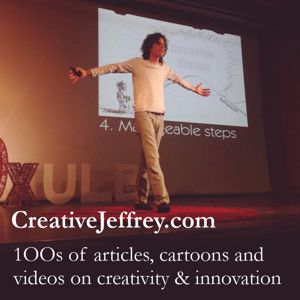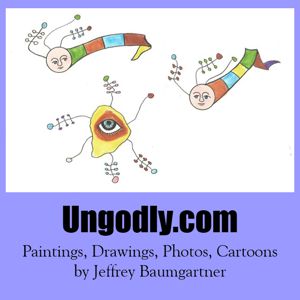Report 103
A weekly newsletter on creativity, ideas, innovation and invention.
Tuesday, 30 November 2004
Issue 44
Hello and welcome to another issue of Report 103, your weekly newsletter on Creativity, ideas, innovation and invention.
As always, if you have news about creativity, idea innovation or invention please feel free to forward it to me for potential inclusion in Report103. Your comments and feedback are also always welcome.
WHEN CREATIVITY GOES STALE
I have often written of the importance of having a variety of people on creative teams. If you want innovative new marketing ideas, the worst possible creative team you could build would be a team composed entirely of people from your marketing department. They would simply continue to have the same ideas they always have had.
That is because the team of people from your marketing department have gone stale. They know each other, they know the kind of ideas the each other will have, they have established methods of working and prefer to stick to those methods. Worse, they probably all come from a similar background and have similar areas of expertise and weaknesses. As a result, they are doubtless good at getting work done according to company rules. They will even continue to have good ideas. But they will have lost that fresh dynamism of a group of people with differing backgrounds, various subjects of expertise and little experience working together. In short they have gone stale.
Even when you create multidisciplinary creative teams (as you always should if you want truly creative teams), you need to move people around regularly. Although a multidisciplinary team will benefit from a variety of backgrounds, it will still go stale in time. People will get used to each other and the team will establish routines which improve their efficiency, but also limit their thinking. Certainly they will continue to come up with creative ideas, but those ideas will be less frequent and probably less brilliant.
The solution is simple. Shuffle people from team to team so that the members of each team are regularly changing. Such changes need not take place every week. Depending on the kind of projects they work with, team members should probably be shuffled every six to 12 months to maintain a balance of creativity with working synergy.
But just as teams need a variety of people in order to generate creative ideas and implement innovative solutions, so too do individuals need a variety of tasks to prevent their creativity from going stale. If an employee is exceptionally good at a particular job, the worst thing you can do – from an innovation standpoint – is leave her in that job indefinitely. Although she will likely continue to perform her responsibilities well, she will likely get bored within a very few years. Certainly, her innovativeness will fade as her work changes from accomplishing new challenges to following routines.
Some people like routines and prefer the security of doing something they know they do well. And, for many kinds of work, there is nothing wrong with that. But if you want creative solutions and innovative results, there is clearly a problem. Moreover, creative thinkers will quickly get bored without change of responsibilities. At best, their work will become routine and at worst they will leave the company altogether.
It is best to assume that if an employee is exceptionally good at one particular job, she is almost certainly good at other jobs as well. By moving her from position to position every few years, you will maximise her innovative contribution to the organisation as well as give her increased job satisfaction.
For the self employed, there is also a danger of becoming stale. If you have found that you can do a particular kind of work well and earn good money doing it, it is all too easy to become complacent with the income and professional respect you gain from such a situation. It is also all to easy to grow bored. It is necessary to either grow your own business with new products or services, possibly in partnership with other self-employed people; or to reinvent your business – and probably yourself - altogether. The latter, though is a real challenge and should not be attempted without suitable savings to keep your cash-flow moving. You will find that you can reinvent yourself faster than your clients can.
SLOW CREATIVITY
In last week's Report 103 (http://www.creativejeffrey.com/report103/archive.php?issue_no=20041123), I wrote about the importance of imagination and suggested that companies should give prospective employees a test of their imagination skills during job interviews. Pete McVeigh of BT's Northern Ireland Innovation and Opportunities division took me to task on that article. While he agreed that imagination is important, he reminded me that not everyone can be creative on the spot. He pointed out that “in ideation sessions I have seen some of the best, most imaginative ideas come from the person who sits and appears to let the conversation flow round (and over)them and then comes forward with an absolute gem, or the person who sits and stares at the sea for two hours before getting that 'Eureka' moment!”
In response to Pete's sheer audacity for questioning my authority on innovation, I can only say: he is absolutely right! Indeed, not only have I seen similar situations, I have even been in the shoes of the slow thinker on more than one occasion.
In fact, during brainstorming sessions, the most creative ideas usually are ideated after about 10 to 15 minutes. The rush of ideas with which most brainstorming sessions begin are typically predictable and not very creative. It takes time for people to move from the obvious ideas already floating around in their minds to creative ideas which they must develop in their minds.
Likewise, I can think of many occasions where I have been asked for ideas, but at the time was unable to come up with anything particularly creative. Then, an hour or two later my mind suddenly delivers a killer idea. Moreover, I expect you have been in the same kind of situations yourself, haven't you?
This has several implications for managers:
A) Communication: If someone has an idea an hour or two after a meeting, there should be a means for her to communicate that idea to management. At the very least this will be a receptiveness to ideas on the management's part. Needless-to-say, if your company has a culture of innovation, this receptiveness will be there at all times. Better still, an idea management tool (such as Jenni idea management: http://www.creativejeffrey.com/jenni/) will allow employees to contribute ideas at any time.
B) Brainstorming: Brainstorming is a fantastic way to generate a lot of focused ideas in a very short time span. Using criteria based evaluation (see http://www.creativejeffrey.com/report103/archive.php?issue_no=20040720 for more info on evaluations), you can complete the brainstorming session with a list of ranked best ideas within 60-90 minutes of beginning the session. But brainstorming sessions are limited in time and number of participants. An alternative approach is to run ideas campaigns. Ideas campaigns are like brainstorming sessions, but the ideation phase lasts for a minimum of several days and for as long as four weeks (we recommend one to two weeks as optimal). Idea campaigns allow everyone in the enterprise or another defined group to contribute ideas on a particular issue. At the end of the ideation period, you use criteria based evaluation to determine the best ideas. Ideas campaigns can be done via an electronic notice board, via a suggestion box or via e-mail. In addition several firms, including ours, offer software for running and managing ideas campaigns. Our Sylvia web brainstorm and web IdeasCampaign tool allows you to set up and run brainstorming sessions or ideas campaigns quickly and easily (see http://www.creativejeffrey.com/sylvia/). Our idea management tool also permits you to run focused ideas campaigns.
C) Hiring creative thinkers. Last week I advised that when interviewing prospective employees, you should create unusual scenarios and ask the interviewees how they would cope. I still believe this is a good tactic, particularly if you need people who can think quickly on their feet. However, I would also suggest giving interviewees some creative homework to prepare prior to the Interview. For instance, if you are hiring a sales manager, tell her prior to her interview that you will ask her how she would try to sell your product to an Estonian purchasing manager who spoke no English (bringing a translator along is not an acceptable solution). Not only does this give the interviewee a chance to think about creative solutions, it also helps set the tone for a creative interview.
The moral of this article is that managers have to understand that creativity can operate at a variety of speeds. It is critical to set up methods and tools that can accept ideas whenever and however they arrive. It is also important to understand your creative thinkers. Some will need time to think through their ideas, others will be particularly good at coming up with quick solutions.
A final note: I always welcome your comments and criticisms on articles in Report 103 and have had some very thought provoking exchanges with a few of you. If you have comments on what you read here, I welcome them.
SWEDEN AND FINLAND ARE EU'S LEADING INNOVATORS
The 2004 European Innovation Scoreboard (EIS), an annual evaluation of each European Union member state's level of innovation, has just been released. It ranks Sweden and Finland as the union's leading innovators. Estonia and Slovenia are the top performing innovators of the ten new members of the EU.
The EIS was established by the European Commission and looks at “20 indicators, measuring human resources, the creation of new knowledge, the transmission and application of knowledge, and innovation finance. A composite indicator provides an overview of national performances.”
You can read more on the Cordis web site as well as download the scorecard itself. .
Happy thinking
Jeffrey Baumgartner




